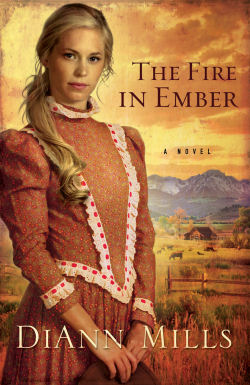
DiAnn Mills believes her readers should “Expect an Adventure.” She is a fiction writer who combines an adventuresome spirit with unforgettable characters to create action-packed novels. Her books have won many awards through American Christian Fiction Writers, and she is the recipient of the Inspirational Reader’s Choice award for 2005, 2007, and 2010. She was a Christy Award finalist in 2008 and a Christy winner in 2010. DiAnn is a founding board member for American Christian Fiction Writers, a member of Inspirational Writers Alive, Advanced Writers and Speakers Association, and is the Craftsman Mentor for the Christian Writer’s Guild. She speaks to various groups and teaches writing workshops. DiAnn and her husband live in Houston, Texas. Visit her website at: www.diannmills.com or find her on Facebook at http://www.facebook.com/diannmills |
|||||||||||
Welcome to DiAnn Direct!Building A Story Idea |
|||||||||||
|
You have a story idea; it’s banging against your head and heart. You’re not sure what to do with it, and you’re afraid of losing it. So let’s turn your burning thoughts into a book project. Ready? Are your fingers poised on your keyboard? Our exercises will take a little time. Step One: Write your story idea in one sentence. Don’t concern yourself with character names. That part of writing will come in the next lesson. Here are a few examples. 1. A young mother confesses to her husband that she is not only addicted to drugs, but she also deals them. 2. A businessman discovers the owner of his company is smuggling assault rifles into the country. 3. A newly married couple is left behind on a wagon train when the husband is suspected of carrying a terrible disease. 4. A young woman travels west to marry a man she’s never met, only to discover he never existed. Congratulate yourself. You have now given your story life. Now perfect your one sentence storyline. Tweak it here and there until you’re satisfied. Do you envision your protagonist(s) and antagonist? Some of you may not grasp the definition of a protagonist, an antagonist, and a villain. •A protagonist is the character
who has a worthy goal to achieve. This character is your champion. Step Two: Take your one-sentence idea and write at least one paragraph about your story. Extend your idea to include what you know about your characters and the storyline. Close your eyes while you write this. Don’t worry about grammar and punctuation. Simply visualize your story. When you’re finished, edit your paragraph(s). Step Three:
What is your story’s genre? Take a look at the two lists below and find
a home for your story idea. Story
ideas often mix genres
with romance, such as the following: By using a thread of romance in your stories, you can increase your readership. It’s been said that 80 percent of book buyers are women, 50 percent of whom buy romance. Do the math and add a spark of love to your book project. Step Four: Where is your story set? Writers often view story setting as a character, possibly as an antagonist that attempts to stop the protagonist from reaching his goal. This aspect helps build tension and conflict into your story. By establishing a time period and area of the world—or beyond—you are able to establish the culture, vocabulary, and values of your characters. |
Step Five: Establish a cast of characters. List the characters you will need to carry your story idea to completion. Limit your cast to twelve or fewer. Give these characters names, but understand that these names may change once we dive into characterization. On the left side of your paper, or your computer screen, list each character’s name. On the right side, list the role your character plays. Do your best to give your character multiple roles. This adds to the tension and conflict of your story. The list will look something like this:
Step Six: What do you want your readers to learn from this novel? In other words, when your readers finish the last page, what will be the takeaway value? Write that down. A writer must have a reason to compose a story. This is your passion, the reason why you spend hours learning the craft and applying those tools to a worthy book project. Take a deep breath. You’ve just completed the basics to writing a novel. Look at what you’ve accomplished and check off each item. Step Six: What do you want your readers to learn from this novel? In other words, when your readers finish the last page, what will be the takeaway value? Write that down. A writer must have a reason to compose a story. This is your passion, the reason why you spend hours learning the craft and applying those tools to a worthy book project. Take a deep breath. You’ve just completed the basics to writing a novel. Look at what you’ve accomplished and check off each item. Step One: Write a one sentence story concept. Step Two: Write a paragraph(s) about your story idea. Step Three: Establish the genre. Step Four: Establish a setting. Step Five: Establish a cast of characters and roles. Step Six: Establish the takeaway value. Next month we’ll talk about characterization. This is one of my favorite topics. We’ll dive into what makes a story unforgettable and how to determine character traits and motivation. Until then, keep writing! 
|
||||||||||
|
|
|
|
|
|









 Story
ideas can be like firecrackers. They burst into the air and explode
into beautiful colors for the viewers to delight in. Then they fizzle
to the ground until the next one grabs our attention. But story ideas
don’t have to spread across our vivid imaginations then fade away. A
writer can take those wild, crazy moments of inspiration and build a
credible, colorful, creative, and compelling story.
Story
ideas can be like firecrackers. They burst into the air and explode
into beautiful colors for the viewers to delight in. Then they fizzle
to the ground until the next one grabs our attention. But story ideas
don’t have to spread across our vivid imaginations then fade away. A
writer can take those wild, crazy moments of inspiration and build a
credible, colorful, creative, and compelling story.